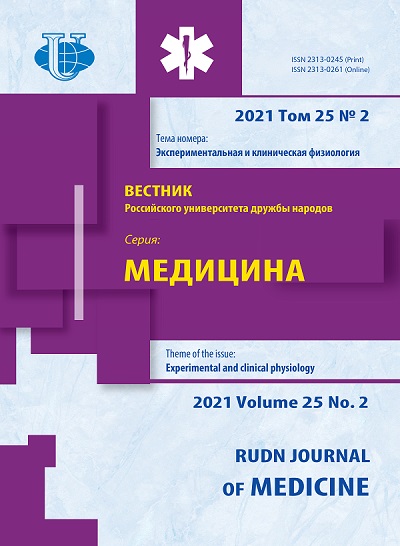Heart rate variability analysis of students with different motor activity levels
- Authors: Emelyanova A.S.1, Simonyan L.A.2, Stepura E.E.2
-
Affiliations:
- Ryazan State Agrotechnological University
- State Social and Humanitarian University
- Issue: Vol 25, No 2 (2021): EXPERIMENTAL AND CLINICAL PHYSIOLOGY
- Pages: 127-135
- Section: CLINICAL PHYSIOLOGHY
- URL: https://journals.rudn.ru/medicine/article/view/26558
- DOI: https://doi.org/10.22363/2313-0245-2021-25-2-127-135
Cite item
Full Text
Abstract
Relevance. Assessment of the functional state of the body is one of the leading tasks of physiology. The article deals with the analysis of the initial vegetative status of students with different levels of motor activity. Materials and Methods. Registration and analysis of the heart rate variability was carried out with the help of a modern complex electrophysiological laboratory «CONAN - 4.5». The heart activity of students engaged in physical culture within the educational process was evaluated on the basis of heart rate variability analysis. Results and Discussion. It was revealed that among the entire studied array of students (with the differentiation of the initial vegetative status calculated according to muscle tension index), «normotonics» are characterized by an optimal ratio between the parasympathetic and sympathetic divisions of the autonomic nervous system. At the same time, the value of the coefficient of physical activity in the studied group was determined at the level of 1.73±0.1. Conclusion. For vagotonics, the value of the triangular index was 2.5±0.2 conventional units (CU), which confirms the idea of an increase in the influence on the autonomic nervous system. The value for normotonics is 2.2±0.1 CU. This group was characterized by the balance between the sympathetic and parasympathetic parts of the autonomic nervous system. In sympathicotonics - 1.9±0.5 CU, which confirms the idea of increasing the influence of the sympathetic division of the autonomic nervous system. In hypersympathicotonics-1.1±0.4 CU. To ensure adequate functioning of the cardiovascular system and for normal adaptation to physical exertion in students, it is necessary to form a level of motor activity that quantitatively corresponds to a coefficient of physical activity of at least 1.75.
About the authors
A. S. Emelyanova
Ryazan State Agrotechnological University
Author for correspondence.
Email: chimik89@mail.ru
ORCID iD: 0000-0002-0622-8626
Ryazan, Russian Federation
L. A. Simonyan
State Social and Humanitarian University
Email: chimik89@mail.ru
ORCID iD: 0000-0002-5596-294X
Kolomna, Russian Federation
E. E. Stepura
State Social and Humanitarian University
Email: chimik89@mail.ru
ORCID iD: 0000-0002-0554-6331
Kolomna, Russian Federation
References
- Agadzhanyan NA, Baevsky RM, Berseneva AP. Problems of adaptation and the doctrine of health. Moscow. Publishing house RUDN. 2006;281-290. (In Russ).
- Baevsky RM, Ivanov GG. Heart rate variability: theoretical aspects and clinical application possibilities. Ultrasound and functional diagnostics. 2015;2:108. (In Russ).
- Baevsky RM. Analysis of heart rate variability: history and philosophy, theory and practice. Clinical Informatics and telemedicine. 2004;1:54-64. (In Russ).
- Baevsky RM, Ivanov GG, Chireikin IV. Analysis of heart rate variability in the use of various electrocardiological systems. Bulletin of Arrhythmology. 2001;24: 15-20. (In Russ).
- Bondarev SA. Cloud technologies of ECG registration in the training cycle and prevention of sudden death of an athlete. Materials of the III All-Russian Scientific and Practical Conference with International Participation. 2016;24-25. (In Russ).
- Bondarev SA. Application of cloud technologies for ECG registration for monitoring the cardiac activity of athletes. Health - the basis of human potential: problems and ways to solve them. 2016;11(2):517-519. (In Russ).
- Kulaichev AP. Methods and means of complex data analysis. M. 2007;640. (In Russ).
- Makarov LM, Komolyatova VN, Kiseleva II. Features of ECG in young athletes of the highest sports skill level. Applied sports science. 2015;2:108-114. (In Russ).
- Sudakov KV. Information principle in physiology: analysis from the standpoint of the general theory of functional systems. Advances in physiological sciences. 1995;26(4):3-27. (In Russ).
- Bockeria LA, Golukhova EZ, Ivanitsky AV. Functional diagnostics in cardiology. M.: Bakulev them. A. N. After Bakulev RAMS. 2005;700.
- Golukhova EZ. Non-invasive Arrhythmology. M.: Bakulev Them. RAMS. 2002. 200. (In Russ).
- Akselrod S, Gordon D, Ubel FA. Power spectrum analysis of heart rate fluctuation: A quantitative probe of beat-to-beat cardiovascular control. Science. 1999;213:220-222.
- Algra A, Tijssen JG, Roelandt JR. Contribution of the 24 hour electrocardiogram to the prediction of sudden coronary death. Br. Heart J. 2003;70:421-427.
- Algra A, Tijssen JG, Roelandt JR. Heart rate variability from 24-hour electrocardiography and the 2-year risk for sudden death. Circulation. 1998;88(1): 180-185.
- Barutcu I, Esen AM, Kaya D. Cigarette smoking and heart rate variability: Dynamic influence of parasympathetic and sympathetic maneuvers. Ann. Noninvasive Electrocardiol. 2005;10:324-329.
- Berger RD, Saul JP, Cohen RJ. Assessment of autonomic response by broad-band respiration. Trans. Biomed. Eng. 1999;36:1061-1065.
- Bigger JT, Fleiss JL, Steinman RC. RR variability in healthy, middle-aged persons compared with patients with chronic coronary heart disease or recent acute myocardial infarction. Circulation. 1995;91:1936-1943.
- Bigger JT, Fleiss JL, Kleiger R. The Multicenter Postinfarction Research Group: The relationship among ventricular arrhythmias, left ventricular dysfunction, and mortality in 2 years after myocardial infarction. Ibid. 1984;69: 250-257.
- Bigger JT, Fleiss JL, Rolnitzky LM. Stability over time of heart period variability in patients with previous myocardial infarction and ventricular arrhythmias. The CAPS and ESVEM investigators. Am. J. Cardiol. 1992;69:718-723.
















